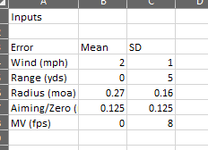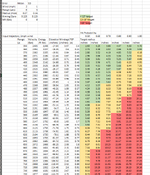I also don't have WEZ and was also curious about taking my own stab at estimating hit rates. I did this in excel and using Berger's online ballistic calculator for the base trajectory inputs. Basically I have a mean and SD quantified for some of the most common and significant sources of error. Note - this is using my same 284 ballistics and data I have quoted in other threads on this topic.

These are user inputs, and should be done to reflect real data gathered on your rifle. I use the mean and sd of shot radius method (again as described in other threads), so I have pretty solid numbers on those, as well as MV. Wind calling is less solid, since it is hard to measure wind, but I arrived at those numbers by saying, on average I call within 2mph, and my worst case call will be within 5mph.
I run two trajectories through Berger's solver, one with baseline inputs and 1mph wind, the other with +1SD of MV. Then I calculate mean, 1sd, 2sd, 3sd, errors in inches for each of the effects above, as a function of range. Wind error per mph is a simple scaling of the Berger outputs for 1mph. Range error per yd is determined by calculating dElevation/dYardage from the baseline trajectory, and scaling that result. Shot radius is a direct angular calculation as a function of range. Same with 0 error and aiming error. MV induced error in inches is calculated using the second trajectory, first by finding dElevation/dVelocity, and then scaling that by MV sd. Here's an example of what it looks like:

I calculate the mean, 1SD, 2SD, 3SD contributions of error for each component. Then for totals, I directly sum the means, but RSS the dispersions (aka the 1SD, 2SD, 3SD columns). For example, the 1SD column is mean + RSS(all 1SD dispersions). The answer looks like this:

Because I know the mean represents a 50% hit probability, 1SD 66%, 2SD 95%, 3SD 99.7%, I can do some interpolating to figure out what is my needed target size to give a certain hit probability at a certain range. Or said differently, given a certain target size and range, I can estimate my hit probability:

Looking at this result, I can compare against some WEZ values
@Formidilosus ran for my gun in a different thread. Now a quick tangent on WEZ vs. my calculator. WEZ doesn't have mean inputs, only SD aka dispersions. I think this is valid for most things, but not for rifle precision or wind calling. The center of the wind calling distribution is not necessarily 0. Said differently, on AVERAGE, most people will have some amount of wind calling error. So to do an apples to apples comparison, I run the following:

Form's WEZ output:

WEZ calculates 58.6% hit probability. I calculate that I have slightly less than 60% chance. Pretty good!
This data is also super informative. Some takeaways:
- If I want ~100% chance of shooting a deer (12" circle), my max range should be 360yds. On elk (18" circle) this goes to 470yds. This ignores shooter induced errors other than aiming.
- Hitting at 600yds is twice as hard as hitting at 400. Hitting at 1000yds is 2.5x as hard as 600. Nonlinear error folks!
- Assuming my system is at least average, MOST people have a <50% chance of hitting a 10" circle at 600yds. This jives with the Cold Bore Challenge results from last year, ~35-40% success rate at 600 if I recall correctly.
I've also been able to mess with various inputs to determine sensitivities to hit rates. Conclusions in this thread are mostly correct, but rifle accuracy sure doesn't hurt! As I've said in other threads, given a "0 sum game" of time, where I have to choose between practicing and developing my rifle system, practicing wind calling and positional shooting is probably the most beneficial use of time. But in my particular situation, I cannot shoot in the mountains at long ranges easily, but I can go to the range and test some different ammo, measure MV, or run the Kraft drill. So my "practice" time is not 1:1 with my development time - I'm going to spend a fixed number of days shooting in the field regardless of if I do some development at the range or not. So I see no harm in it. That being said, "development" has gotten a lot simpler for me as a result of Form's and other's input, and some other studies I've run. See other posts for that.

apcentral.collegeboard.org










